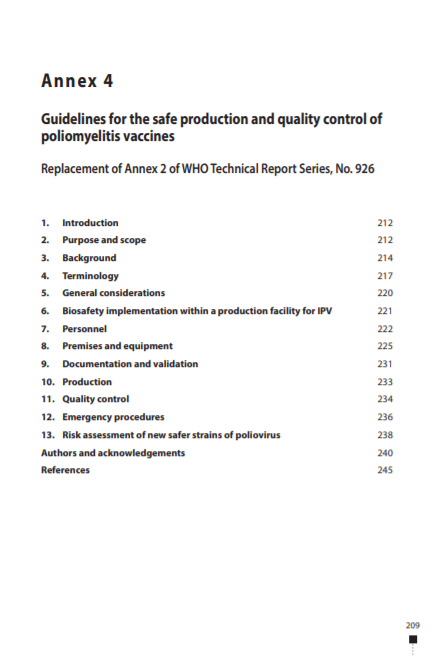Guidelines for the safe production and quality control of poliomyelitis vaccines, Annex 4, TRS No 1016
Replacement of Annex 2 of WHO Technical Report Series, No. 926

Overview
The WHO Guidelines for the safe production and quality control of inactivated poliomyelitis vaccine manufactured from wild polioviruses (1) were developed in 2003 as an addendum to the previous Recommendations for the production and control of poliomyelitis vaccine (inactivated) (2), and specify the measures to be taken to minimize the risk of accidental reintroduction of wild-type poliovirus from a vaccine manufacturing facility into the community after global certification of poliomyelitis eradication.
None of the currently available guidelines and recommendations provides sufficient detail concerning strategies or approaches for satisfying the objectives of both current GMP and GAPIII. Furthermore, some of these documents were developed based on different conceptual frameworks and often use incongruent terminology.
These revised WHO Guidelines provide information and guidance to vaccine manufacturers and relevant national authorities on the biosafety measures required for poliomyelitis vaccine production and quality control during the final poliovirus containment stage (Phase III) as defined in GAPIII (7). The current document specifies the biosafety-related steps to be taken to minimize the risk of accidentally reintroducing poliovirus from a vaccine manufacturing facility into the community after global certification of poliomyelitis eradication, and should be read in conjunction with other relevant WHO guidance (3–7, 10). Detailed and specific guidance on biosecurity has been described in GAPIII (7) and other WHO documents (11), and is therefore not repeated in the current document. Poliomyelitis vaccine manufacturers should implement these biosecurity measures to reduce the likelihood of intentional release of poliovirus.
Full version of the WHO Technical Report Series N° 1016
